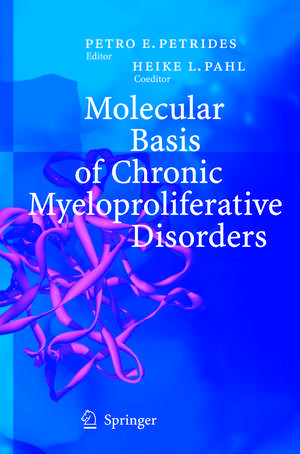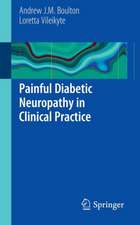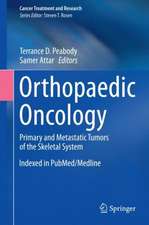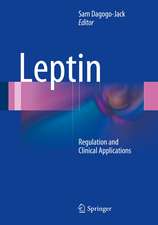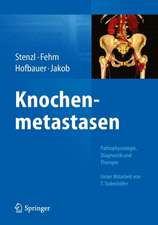Molecular Basis of Chronic Myeloproliferative Disorders
H.L. Pahl Editat de P. E. Petridesen Limba Engleză Paperback – 7 oct 2012
| Toate formatele și edițiile | Preț | Express |
|---|---|---|
| Paperback (1) | 712.46 lei 6-8 săpt. | |
| Springer Berlin, Heidelberg – 7 oct 2012 | 712.46 lei 6-8 săpt. | |
| Hardback (1) | 719.38 lei 6-8 săpt. | |
| Springer Berlin, Heidelberg – 5 oct 2004 | 719.38 lei 6-8 săpt. |
Preț: 712.46 lei
Preț vechi: 749.95 lei
-5% Nou
Puncte Express: 1069
Preț estimativ în valută:
136.34€ • 148.05$ • 114.53£
136.34€ • 148.05$ • 114.53£
Carte tipărită la comandă
Livrare economică 23 aprilie-07 mai
Preluare comenzi: 021 569.72.76
Specificații
ISBN-13: 9783642622717
ISBN-10: 3642622712
Pagini: 236
Ilustrații: XII, 218 p.
Dimensiuni: 155 x 235 x 12 mm
Greutate: 0.34 kg
Ediția:Softcover reprint of the original 1st ed. 2004
Editura: Springer Berlin, Heidelberg
Colecția Springer
Locul publicării:Berlin, Heidelberg, Germany
ISBN-10: 3642622712
Pagini: 236
Ilustrații: XII, 218 p.
Dimensiuni: 155 x 235 x 12 mm
Greutate: 0.34 kg
Ediția:Softcover reprint of the original 1st ed. 2004
Editura: Springer Berlin, Heidelberg
Colecția Springer
Locul publicării:Berlin, Heidelberg, Germany
Public țintă
ResearchDescriere
Since the first description of Philadelphia chromosome-negative chronic myeloproliferative disorders more than 100 years ago, the diagnosis and therapy of these conditions have been based primarily on clinical experience and judgement. Until recently very little was known about the molecular basis of these diseases. In order to spark research in this area basic scientists and clinicians from various parts of the world have contributed to this volume, the first of its kind to put together the current knowledge. The book deals with the new WHO classification of these disorders, novel aspects of diagnostic pathology, the search for disease-relevant genes utilizing molecular biology and proteomic techniques, the description of the roles of PVR-1 and VHL genes for polycythemias and the discovery of the gene mutation responsible for the idiopathic hypereosinophilic syndrome. A chapter on anagrelide, an important novel drug for the treatment of primary thrombocythemia, is included.
Cuprins
Basics.- 1 Introduction: Towards a Molecular Classification of Chronic Myeloproliferative Disorders.- 2 Chronic Myeloproliferative Disorders: A Clinician’s View.- 3 Chronic Myeloproliferative Disorders: A Pathologist’s View.- 4 Cytogenetics of Myeloproliferative Disorders.- Polycythemia Vera.- 5 Classification and Molecular Biology of Polycythemias (Erythrocytoses).- 6 Characterization of PRV-1, a Novel Hematopoietic Cell Surface Marker Overexpressed in Polycythemia Rubra Vera.- 7 Impaired Expression of the Thrombopoietin Receptor, Mpl, in Polycythemia Vera.- 8 Growth Factor Signaling in Polycythemia Vera Cells: Specific Hypersensitivities to Cytokines in the Chronic Myeloproliferative Disorders.- 9 Role of the Antiapoptotic Protein Bcl-xL in the Pathogenesis of Polycythemia Vera.- 10 Involvement of Chromosome 9 and 11 in Familial and Sporadic Polycythemia Vera.- Essential Thrombocythemia.- 11 Essential Thrombocythemia: Regulation of Megakaryocytopoiesis.- 12 Hereditary Thrombocythemia.- 13 Thromboembolic Complications in Essential Thrombocythemia: the Role of the Analysis of the Platelet Proteome.- 14 Clonality Studies in Essential Thrombocythemia.- 15 Molecular and Preclinical Aspects of Anagrelide Action.- Chronic Idiopathic Myelofibrosis.- 16 Prolactin-like Protein E and Megakaryocytopoiesis.- 17 Pathophysiology and Stem Cell Biology in Myelofibrosis with Myeloid Metaplasia.- 18 Transforming Growth Factor ß1 in Myelofibrosis.- 19 Idiopathic Myelofibrosis: Evidence for Pathological Crosstalk Between Polymorphonuclear Leukocytes and Megakaryocytes.- Mastocytosis.- 20 C-kit and Mastocytosis.- 21 Tryptases, a Marker of Occult Mastocytosis.- Hypereosinophilic Syndrome.- 22 Familial Hypereosinophilic Syndrome.- 23 Mononuclear Cell Preparations from Patients with Idiopathic Hypereosinophilic Syndromes Do Not Express the Wilms’ Tumor Gene.- 24 Clonality Analysis and Hypereosinophilia.- 25 Clonal Lymphocytes in Patients with Idiopathic Hypereosinophilic Syndrome.
